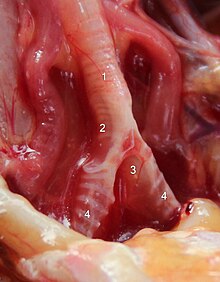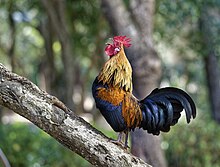Crow cry

The crow call (" Hahneschrei "; from Middle High German kraejen " krähen ", "scream", "shout") is the courtship call of the roosters, which is independent of courtship behavior in the domesticated chicken.
Biomechanics
In birds, the vocal sound is formed in the vocal head (syrinx) , an organ made up of muscles and cartilage, which in chickens is located in the transition area between the distal trachea and the main bronchi . The sounds are amplified by moving parts in the wall at the beginning of the bronchi, the so-called membranae semilunares or tympaniformes , which act as resonance bodies. Compared to songbirds, the muscles of the vocal head in chickens have a simple structure so that the fine modulation of the sounds is relatively limited. The duration and volume of the vocal noises are determined by the size and filling of the lungs as well as the strength of the neck, chest and abdominal muscles (birds do not have a muscular diaphragm). The pressure built up in the vocal head must equalize the pressure in the infraclavicular air sacs for sound formation and can vary between 6 and 50 mm Hg.
Endocrine control
The crowing is a vocal expression that is heard almost exclusively with roosters. However, since hens are also capable of crows, it stands to reason that crows are hormonally controlled. This was proven in one of the first and historically most valuable endocrinological experiments in 1848 by Arnold Adolf Berthold when he first removed the testicles from a rooster and later replanted them. After the castration , the rooster stopped crowing immediately and started again after the testicular reimplantation. The crowing of the hen was first described by Aristotle , but depending on the situation in the context of winning behavior. Hormonal influences can, however, cause the hen to become constantly cranky, be it pathological in the sense of an ovarian disease, be it due to atrophy of the ovaries during aging.
Crow characteristics of the comb chickens

The four types of comb chickens , among which the bankiva chicken (Gallus gallus) is the ancestor of domestic chickens, have different crow calls. The differences are in the number of syllables, duration, accentuation, sound structure and pitch as well as in the intervals between the syllables. The fork-tailed chicken crows relatively high and with two syllables. The Lafayette chicken has a crow call with three syllables and a long interval between the first and second syllable. Sonnerat and bankiva chicken crow with four syllables, with the first type emphasizing the second syllable and the bankiva chicken the third. The fact that the domesticated chicken's crow call is also four-syllable and basically corresponds to the call of the bankiva chicken supports Darwin's monophyletic theory about the ancestry of the domestic chicken.
Function of crowing in the domestic fowl
With the domestication of the domestic chicken, crowing has lost its role as a courtship call. It is assumed that during the domestication process an unconscious selection of the frequently crowing roosters took place. In any case, the interpretation of the crow's function is difficult. Reputation does not play a clear role in the characterization of the territory, nor is the role in the social behavior of the sexes clear.
Crows and long crows
The duration of the crow call in the domestic chicken is comparable to that of the bankiva chicken and averages around 1.6 seconds. Different breeds of chickens have developed into long crows due to the extended duration of the rooster crow . Most of the time, a selection of the longest crowing roosters has taken place here, often in the context of competition crows . The inheritance of the prolonged crow call does not follow Mendel's laws and seems to be based on a combination of several genes. Common features of the long crows breeds are an upright posture, long runs and a long neck, which can be explained by the biomechanical prerequisites for this crowing.
Sensation through people
Due to increasing urbanization, there are many legal proceedings for noise pollution from crowing roosters. In Germany, among other things, §1004 of the BGB is taken into account with regard to possible property impairment . In agricultural areas or areas that were originally used for agriculture, however, the rooster screeching is often rated as customary in the area. In France there are also efforts to recognize the rooster and other rural noises as protected cultural heritage.
Individual evidence
- ↑ Bernd Vollmerhaus: Textbook of the anatomy of domestic animals , Volume 5, Georg Thieme Verlag, Erlangen 2004, p. 166
- ↑ John Ludders: In: Dukes' Physiology of Domestic Animals , John Wiley & Sons, New Jersey 2015, chapter 26
- ^ WB Gross: Voice production in the chicken. In: Poultry science. Volume 43, No. 4, (Oxford) 1964, pp. 1005-1008.
- ^ Arnold Adolf Berthold: Transplantation of the testicles . In: Arch. F. Anat. U. Physiol. phys. Abt. Volume 16. 1849, pp. 42-46.
- ^ Aristotle: Historia animalium , Book IX, Chapter 49, edited by David M. Balme, Cambridge 2002.
- ↑ Thomas R. Forbes: The Crowing Hen: Early Observations on Spontaneous Sex Reversal in Birds, Yale Journal of Biology and Medicine, New Haven CT 1947
- ↑ Nicholas and Elsie Collias: A Field Study of the Red Jungle Fowl in North-Central India , in: The Condor , Vol. 69, No. 4, pp. 360-386
- ^ A b Gail Damerow: Storey's Guide to Raising Chickens , 3rd edition, Storey Publishing, North Adams MA 2010
- ↑ Sawai, Hiromi, et al .: The origin and genetic variation of domestic chickens with special reference to junglefowls Gallus g. gallus and G. varius, PloS one 5.5 (2010): e10639.
- ^ Charles R. Darwin: The variation of animals and plants under domestication, John Murray, London 1868.
- ↑ D. Wood-Gush: A History of the Domestic Chicken from Antiquity to the 19th Century , Poultry Science, Vol. 38, No. 2, Oxford 1959, pp. 321-326.
- ↑ T. Kuwayama et al .: Crowing Characteristics of Jungle Fowls, Japanese Native Breeds and White Leghorn Breed of Chicken, Japanese Poultry Science, 3 (2), 1996, p. 89-96.
- ↑ Armin Six and Bettina Müller: Inheritance in chickens and water fowl , Oertel + Spörer, Reutlingen 2007
- ↑ German Civil Code, §1004 , accessed on June 8, 2019
- ↑ Post on francetvinfo.fr (Radio France) on the discussion on the assessment of rural noise, dated May 24, 2019 , accessed on June 8, 2019


